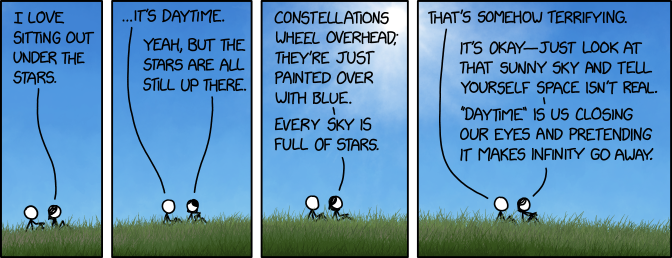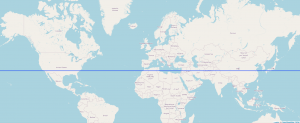Under the Stars

If you live in Los Angeles (around 33°52'N, roughly the latitude of Hermosa Beach) the black hole in V404 Cygni passes over you each day. On Christmas Day it will be directly overhead around 2pm.

If you live in Los Angeles (around 33°52'N, roughly the latitude of Hermosa Beach) the black hole in V404 Cygni passes over you each day. On Christmas Day it will be directly overhead around 2pm.
The phrase "under the stars" generally refers to being under a visible field of stars — either real stars visible at night, or representations of stars constructed by people, as in a dance hall. Megan points out that we're always under the stars, they're just obscured ("painted over") during the day by the brightness of the Sun and its interaction with the sky. Of course, this makes the 'under the stars' part of the remark redundant in the first place, because by this definition, sitting outside is always under the stars. Also, since the Sun is itself a star, regardless of whether or not the other stars are visible when it's daytime, you would always be under at least one visible star. In fact, sitting inside is arguably under the stars as well, since the stars are still there, just obscured by a roof or other construction. Poetically, though, it could be taken to mean that Megan simply loves to sit and ponder the very existence, vastness, numerousness, etc. of the stars, even when she can't see them.
 If you live on the blue line, the black hole in V404 Cygni is directly over you once a day. Zoomable version here.
If you live on the blue line, the black hole in V404 Cygni is directly over you once a day. Zoomable version here.This is related to the concept of object permanence, which is the understanding that objects continue to exist even though we can't physically sense them. When you close your eyes, the universe doesn't go away even though you can't see it; similarly, when the Sun is shining, the stars are still all there.
In the early days of xkcd, it was common for Randall to publish a comic that was not intentionally funny — often also featuring Cueball and Megan — so this is a bit of a return to form.
The title text mentions V404 Cygni, a binary system composed of a 9-solar-mass black hole and a star smaller than the Sun. With a declination of +33° 52′ 02.0″, once every 23 hours and 56 minutes (366.24 times per year, compared to 365.24 solar days within the same timeframe), it 'passes over' any point of the rotating Earth with that latitude north, like Los Angeles, Atlanta or Beirut.
The night sky being "terrifying" is probably related to a quote from Blaise Pascal:
- “I see the terrifying spaces of the universe that enclose me, and I find myself attached to a corner of this vast expanse, without knowing why I am more in this place than in another, nor why this little time that is given me to live is assigned me at this point more than another out of all the eternity that has preceded me and out of all that will follow me.” [1]
This may also be a subtle reference to the short story Nightfall by Isaac Asimov and the related novel (also with Robert Silverberg). This story takes place on a planet that has so many suns that they never have darkness and can never see the stars. In that story an eclipse occurs every 2049 years which causes a complete psychological breakdown of everyone on the planet, as they all fear the dark and have no concept of the vastness of space nor of the existence of other stars. In this comic, the reference to a sky full of stars being "terrifying" is reminiscent of that short story and novel.